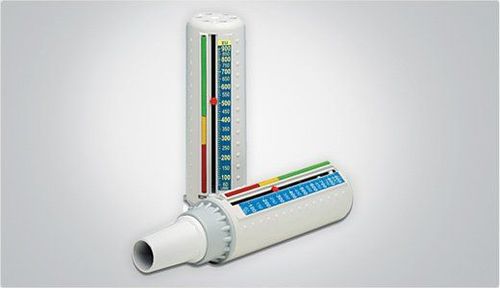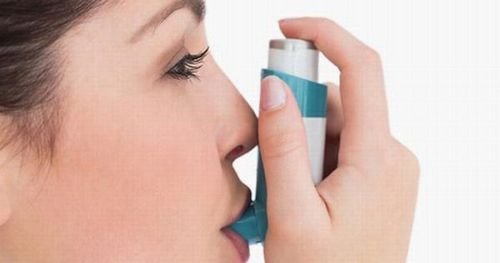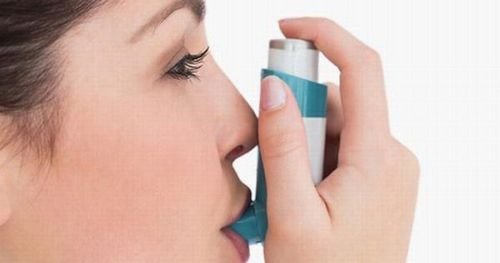This is an automatically translated article.
The article was professionally consulted by Dr. Nguyen Van Dinh - Head of Respiratory - Asthma - Allergy - Clinical Immunology Unit, Vinmec Times City International Hospital.Asthma is the folk name for bronchial asthma. This is a chronic respiratory disease that can affect both children and adults. The disease occurs due to the body's response to allergens, related to genetic factors and external environmental factors. Currently, the method of measuring the peak expiratory flow rate is a common test with high efficiency in the diagnosis and monitoring of asthma treatment.
1. What is Peak Expiratory Flow?
Peak expiratory flow (PEF) is the maximum amount of air a person can exhale. Peak flow is a simple, easy-to-implement, high-reliability index in diagnosing and evaluating asthma, helping patients to monitor their condition at home.
Peak flow measurement is usually done at home with an inexpensive hand-held device called a peak flowmeter. Both electric and non-electrical devices are available in the market. The device is very easy to use and most patients older than 5 years can measure and read the results themselves.
Cases that need to monitor peak expiratory flow:
Used to diagnose asthma:
Have asthma symptoms + spirometry is normal. Has asthma symptoms + spirometry cannot be measured. Diagnosis of occupational asthma: changes in PEF at work and at home. Used to assess the degree of asthma control:
Especially in asthmatic patients who have poor awareness of asthma symptoms.
2. How to measure peak expiratory flow

Kiểm tra lưu lượng đỉnh thở ra PEF được thực hiện bằng một lưu lượng đỉnh kế
PEF peak flow testing is performed with a peak flowmeter. This is a simple hand-held instrument with a bellows on one end and a scale on the other. A small plastic arrow moves as air is blown into the tube, measuring the air flow rate.
Steps to perform peak expiratory flow measurement :
Patient can sit down or stay upright Reset to zero on peak flow meter After maximal inhalation, mouth closed over tip of bellows you exhale quickly, forcefully into the peak flowmeter, removing the peak flowmeter from your mouth before inhaling the next breath. Repeat the movement a second time according to the steps above, each time spaced up to 2 seconds. Record the highest reading The best peak flow index is the parameter recorded when the patient has controlled the asthma attack asthma (no difficulty breathing at all, completely comfortable) for 2 weeks. A reading below the best is a warning sign of an asthma attack.
Note: If you cough or sneeze while exhaling, you will need to start over.
To determine “My Best”, peak flow should be measured:
At least twice a day for 2 to 3 weeks; In the morning upon waking and in the late afternoon or early evening; 15 to 20 minutes after using an inhaled, fast-acting beta 2 agonist (asthma medicine).
3. PEF index in bronchial asthma

Tình trạng bệnh hen phế quản phải được chẩn đoán chính xác, phân loại 4 mức độ từ nhẹ đến nặng
In order to effectively treat asthma with medication, it is necessary to assess the severity of the disease. Depending on the symptoms of an asthma attack, depending on the peak expiratory flow (PEF: Peak Expiratory Flow)) when measured with a peak flow meter, there are 4 levels from mild to severe as follows (according to GINA guidelines):
Level 1 ( asthma attacks): symptoms < 1 time/week, nocturnal symptoms < 2 times/month, PEF >80% of normal expiratory flow value. Level 2 (mild intermittent asthma): symptoms > 1 time/week, nocturnal symptoms > 2 times/month, PEF >80% of normal expiratory flow value. Level 3 (moderate persistent asthma): symptoms occur every day, nocturnal symptoms > 1 time/week, PEF = 60 - 80% of normal expiratory flow value. Level 4 (severe persistent asthma): persistent symptoms that limit activities, nocturnal symptoms often torment the patient, PEF <60% of the normal value of expiratory flow. Peak flow PEF measures how fast you can exhale with exertion. The results from the measurement will be compared with the normal value supplied with the meter. These normal PEF values vary by age, sex, height, and race. Use that to find your normal range. If you find your results are smaller than the normal range, tell your doctor for a follow-up exam. Typically, the peak expiratory flow index fluctuates slightly during the day. It is usually low in the morning and higher in the afternoon. The PEF index in severe asthma fluctuates greatly during the day.
Peak flow plays a role in the diagnosis of asthma, especially in settings that do not have facilities for measuring respiratory function. On the other hand, peak flow is a useful means to help patients and doctors monitor the disease, assess treatment, predict acute asthma attacks so that timely and appropriate treatment can be made.
Asthma is a chronic inflammatory disease. respiratory mucosa, if not diagnosed correctly, the management of asthma will be very difficult. Therefore, patients need to be examined and treated at reputable clinics and hospitals as soon as possible. Vinmec Hospital is a prestigious address for asthma examination and treatment. With a team of highly qualified and dedicated doctors in their work, you and your loved ones will be examined, accurately diagnosed and proposed an effective treatment and control plan for asthma.
Customers can directly go to Vinmec Health system nationwide to visit or contact the hotline here for support.














